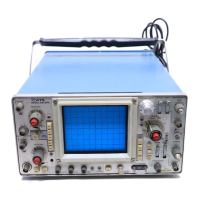TM 11-6625-2735-14-1
Pin 9. Ground terminal.
Pin 10. This is the holdoff output; connected to ground
in this application,
Pin 11. This terminal lights the READY light when
operating in the single sweep mode.
Pin 12. This is the single sweep mode terminal. When
+5 volts is connected to this terminal, the sweep operates
in the single sweep mode; when the terminal is left open or
grounded, the sweep operates in the repetitive mode.
Pin 13. Connected to ground in this application.
Pins 14 and 15.
Single Sweep reset terminals. Pressing
the SINGL SWP pushbutton prepares the single sweep
circuitry to respond to the next triggering event. Also, this
action causes the READY light to be lit.
Pin 16. This is the holdoff start input terminal. A HI on
this pin resets the sweep and starts the holdoff period.
This sets pin 17 HI to reset and hold the trigger tunnel
diodes LO and allows pin 3 to go HI.
Pin 17. This is the sweep disable output terminal. The
gate level at this terminal is HI during holdoff and LO
otherwise.
Pin 18. This is the lockout input terminal; +5 volts
applied to this terminal disables all sweep action.
Pin 19. This is the auto mode terminal. Grounding this
terminal enables auto sweep operation.
Pin 20. Input terminal for the +5-volt supply.
Main Gate Comparator
Q1572 and Q574 form the Main Gate Comparator and
are connected as a voltage comparator, where both
transistors do not conduct at the same time. The input
signal to the stage is the positive-going trigger signal from
the A Firing Trigger TD in the A Trigger Generator circuit.
The signal at the collector of Q574 is inverted by Q588, is
connected to the Z Axis Logic Multivibrator to control
CRT blanking, and to Q584 to generate the A + GATE
output signal. The signal at the collector of Q572 connects
to the base of the Main Gate Amplifier stage (Q902) in the
Sweep Generators circult to initiate sweep generation.
Delayed Gate Comparator
Q802 and Q804 form the Delayed Gate Comparator and
are connected as a voltage comparator where both
transistors do not conduct at the same time. The input
signal to the stage is the positive-going trigger signal from
the B Firing Trigger TD in the B Trigger Generator circuit.
The signal at the collector of Q804 is inverted by Q826 and
is connected to the Z Axis Logic Multivibrator to control
CRT blanking and to Q824 to generate the B + GATE
output signal. The signal at the collector of Q802 connects
to the base of the Delayed Gate Amplifier stage (Q996) in
the Sweep Generators circuit to initiate sweep generation.
A Trigger TD Reset Circuit
Transistors Q612 and Q628 are connected as a Schmitt
Trigger circuit and form the A Trigger TD Reset Circuit. (A
Schmitt Trigger circuit is a bistable pulse generator in
which an output pulse of constant amplitude exists only as
long as the input voltage exceeds a certain dc value.)
At the start of holdoff, pin 17 of U600 steps HI. This
turns on Q612 and turns Q628 off. The collector signal of
Q612 connects to the Trigger Tunnel Diodes in the A
Trigger Generator circuit and resets them to their LO
state. At the end of holdoff pin 17 steps LO, Q612 turns off,
and Q628 turns on to allow the tunnel diodes to fire on the
next trigger signal.
Holdoff Start Circuit
Q594 and Q596 form the Holdoff Start Circuit. The
input signal to the stage is a momentary positive-going
end-of-sweep signal from the Sweep Generators circuit or
from the Delayed Latch circuit. The positive-going signal
turns Q594 on which in turn turns on Q596. The positive-
going signal at the collector of Q596 is connected to pin 16
of U600 to reset the sweep and start the holdoff period.
This signal is also used in the Vertical Switching Circuit to
switch between channels in the ALT mode of operation.
Z Axis Logic Muitivibrator
Q688 and Q698 are basically a Schmitt Trigger circuit
and form the Z Axis Logic Multivibrator. Quiescently, with
the CRT display blanked, Q688 is on and Q698 is off. The
signal to switch states of the multivibrator (and thereby
unblank the CRT) can come from the Main Gate Com-
parator (via Q588 and CR681) or from the Delayed Gate
Comparator (via Q826 and C684). The negative going
signals turn off Q688 and cause Q698 to turn on. The
positive going signals that return the multivibrator to its
original state (thereby blanking the CRT display) come
from Q588 via CR682 and CR683, or from Q680 via CR680
and CR683. Q680 is used primarily to ensure proper early
turn-off of the CRT display at faster sweep rates. In the
3-14

